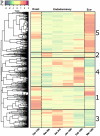Transport capacity is uncoupled with endodormancy breaking in sweet cherry buds: physiological and molecular insights
- PMID: 38752012
- PMCID: PMC11094712
- DOI: 10.3389/fpls.2023.1240642
Transport capacity is uncoupled with endodormancy breaking in sweet cherry buds: physiological and molecular insights
Abstract
Introduction: To avoid the negative impacts of winter unfavorable conditions for plant development, temperate trees enter a rest period called dormancy. Winter dormancy is a complex process that involves multiple signaling pathways and previous studies have suggested that transport capacity between cells and between the buds and the twig may regulate the progression throughout dormancy stages. However, the dynamics and molecular actors involved in this regulation are still poorly described in fruit trees.
Methods: Here, in order to validate the hypothesis that transport capacity regulates dormancy progression in fruit trees, we combined physiological, imaging and transcriptomic approaches to characterize molecular pathways and transport capacity during dormancy in sweet cherry (Prunus avium L.) flower buds.
Results: Our results show that transport capacity is reduced during dormancy and could be regulated by environmental signals. Moreover, we demonstrate that dormancy release is not synchronized with the transport capacity resumption but occurs when the bud is capable of growth under the influence of warmer temperatures. We highlight key genes involved in transport capacity during dormancy.
Discussion: Based on long-term observations conducted during six winter seasons, we propose hypotheses on the environmental and molecular regulation of transport capacity, in relation to dormancy and growth resumption in sweet cherry.
Keywords: Prunus avium L.; bud dormancy; callose; temperature; transcriptomics; transport capacity.
Copyright © 2023 Fouché, Bonnet, Bonnet and Wenden.
Conflict of interest statement
The authors declare that the research was conducted in the absence of any commercial or financial relationships that could be construed as a potential conflict of interest.
Figures







References
-
- Alexa A., Rahnenfuhrer J. (2023). topGO: Enrichment Analysis for Gene Ontology (R package version 2.52.0). https://bioconductor.org/packages/release/bioc/html/topGO.html.
-
- Aloni R., Raviv A., Peterson C. A. (1991). The role of auxin in the removal of dormancy callose and resumption of phloem activity in Vitis vinifera. Can. J. Bot. 69 (8), 1825–1832. doi: 10.1139/b91-232 - DOI
LinkOut - more resources
Full Text Sources
Molecular Biology Databases

